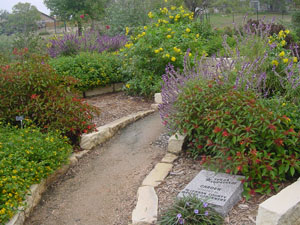


Landscape Planning and DesignA WaterWise landscape doesn't just happen. It is intentionally designed to enhance the natural space with minimal environmental impact. Texas AgriLife Extension Service has an extensive program called EARTH-KINDTM that takes into account many factors in addition to water use. For more about that program, visit their Web site:
The structure, composition, and prior cropping patterns of the soil in the landscape greatly influences the way it must be managed for proper landscape establishment. It is important to have the soil tested to assess a starting point for soil management. For more about soil tests visit the TAMU soil testing lab Web site:
Plants used in the plan should be suited to the native soil and soil should be of sufficient depth to support the selected plant material. Because soil types may vary widely even within the same city, a soil test is essential before plant selection begins. While soils may be amended to accommodate specific plant material, the best plan is to put the plants in place that are best adapted to the native soil. In the case of a new subdivision, native soil may have been displaced and soil tests are necessary to evaluate the condition of the remaining topsoil. A minimum of eight inches of soil is recommended for turf. Soil requirements of the plant material most commonly available in Texas can be found in the PlantSelector section of this web site. Land contours dictate drainage. The landscape should be shown to prevent unwanted overflow into the residence, nearby residences, or into the street. Runoff from buildings should be channeled into plant material to clean water before moving it into storm drains. Advanced design would allow runoff from building roofs to be captured for use in landscape irrigation. Thirsty plant material should be placed at the bottom of hills. On a large lot or commercial campus, areas close to the buildings may be designed for more intensive care while areas in outlying space are left more natural requiring little or no supplemental irrigation. Irrigation requirements of plant material most commonly available in Texas can be found in the PlantSelector section of this Web site.
Hardscape can be used in areas not amenable to plant material. Potential runoff from hardscape should be taken into consideration. Ponds, swales, berms, and rain gardens should be used to manage water flow. Hardscape decorative mulch should be used in narrow or odd shaped areas to avoid watering overspray. Rain catchment for reuse in the landscape is an advanced practice that adds greatly to the water efficiency of a landscape during times of normal rainfall. Irrigation system design should be done in conjunction with landscape design and plans should be reviewed by the same entity at the same time. Construction schedules require that all review of landscape plans be carried out in an efficient and scheduled manner since the landscape and irrigation systems are often installed during construction, particularly in new subdivisions. Treatment of slopes. Plant selection criteria include use of groundcover or other erosion-prevention such as compost in place of turf on slopes greater than. Designs should indicate a range of plants for specific areas rather than narrow specification due to the fluctuations in plant availability. A landscape contractor may be able to get a plant with the same characteristics, but not a specific plant, according to stringent scheduling. |
|
|
|
